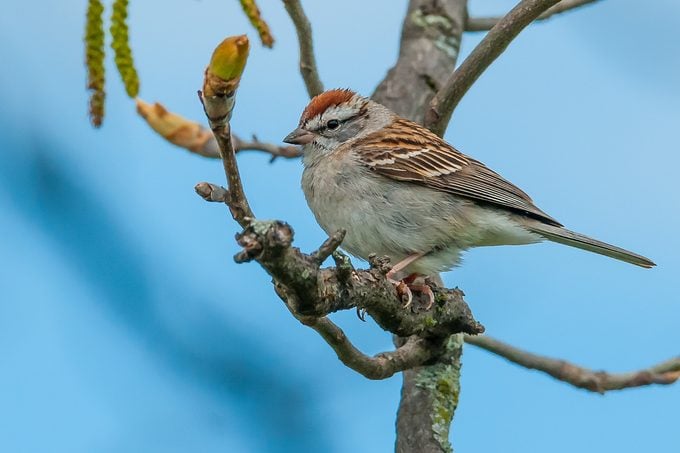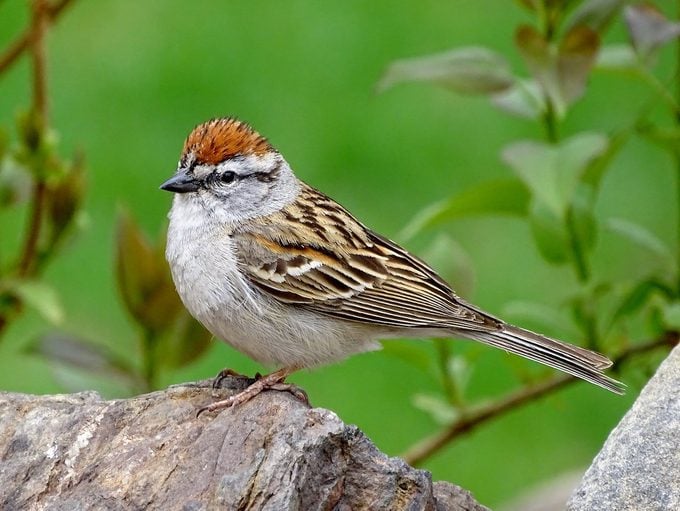How to Identify and Attract a Chipping Sparrow
Updated: Jun. 25, 2024
The happy trills of a native chipping sparrow can be heard from coast to coast. Bring this cheerful summer bird into your yard.

For prolific author Sneed B. Collard III, chipping sparrows hold a special place in his memory. When doing field research for his book Fire Birds, he accompanied Richard Hutto, currently an emeritus professor of biology and wildlife biology at the University of Montana, out bird-watching.
“I clearly recall him pointing out the buzzy trill of the chipping sparrow,” Sneed says. Richard had pointed out that this species sounds like someone rapidly running a stick along a picket fence. “I’ve never forgotten that,” says Sneed, “and now I eagerly listen for the return of that picket fence sound each spring.”
On This Page
What Do Chipping Sparrows Look Like?

The most noticeable field mark for chipping sparrows is the chestnut brown cap on top of their heads, but the feature that helps really identify them from similar-looking species, such as field, clay-colored, Brewer’s and American tree sparrows, is the black eyeline stripe.
“The dark eyeline runs all the way to the bill on chipping sparrows,” Sneed says, “but it doesn’t extend past the eye in other species.” Adult chipping sparrows are plain chested, lacking the streaks and spots of many sparrows, but summer juveniles are streaked at first. Males and females look similar, and both show duller coloring during the nonbreeding winter season.
Chipping Sparrow Nests and Eggs

When available, horsehair is a common lining for chipping sparrow nests, though hair from deer and small mammals is often used too. Chipping sparrow nests are most often in evergreen trees, usually built less than 10 feet off the ground.
While the females build the nests, the males stand guard. Like many sparrows, they’re a bit picky about where they build; the female might start several nests before she settles on a single location.
Chipping sparrows typically lay two to seven pale blue eggs and will raise one to three broods in a single season.
Learn how to identify a song sparrow.
Chipping Sparrow Sounds and Calls
Bird sounds courtesy of the Cornell Lab of Ornithology
Chipping sparrows are named for the series of rapid chip trills of their “picket fence” song or the various single chip note calls they make. The sharp chip notes are used year-round to stay in contact with nearby birds.
Dark-eyed juncos make nearly identical sounds and occupy similar habitats as chipping sparrows, so listen closely for the slight differences!
What Do Chipping Sparrows Eat?

Chipping sparrows are seedeaters. They will come to feeders and are especially fond of open trays, fly-through platforms and hoppers. Black oil sunflower seeds, white proso millet and sunflower chips are favorite eats for chipping sparrows. Small amounts of seed can be sprinkled directly on the ground, preferably near some cover, for these native sparrows.
Sneed most often encounters chipping sparrows feeding on the ground, and adds that insects “form a great part of their diets during breeding season.”
Backyard Tip: Plant grasses if you want to support chipping sparrows. Native and ornamental grasses offer plenty of seed for this ground bird.
Range and Habitat

During spring and fall migration, chipping sparrows can show up anywhere in North America. “You often see them in parks, yards, weedy fields and other open habitats adjacent to some kind of shelter plants,” Sneed says.
With the exception of parts of the southern Great Plains, the breeding range for chipping sparrows extends from Georgia to central Alaska. In winter they can be found across the southern states from California to Virginia, and southward into Mexico.
There are also year-round populations in Mexico and Central America.
Sources
- All About Birds – chipping sparrow
- National Audubon Society – chipping sparrow
- ABC BIrds – chipping sparrow
About the Expert
Award-winning author Sneed B. Collard III has penned nearly 100 books for children and young adults, including many about birds, science and nature. In 2010, he launched his own publishing company, Bucking Horse Books, He is based in Montana.

























